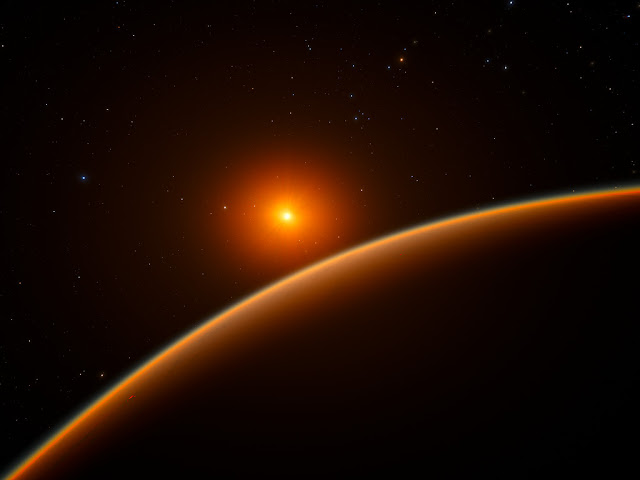Location of the faint red star LHS 1140 in the constellation of Cetus (The Sea Monster)
Videos
[1] The habitable zone is defined by the range of orbits around a
star, for which a planet possesses the appropriate temperature needed
for liquid water to exist on the planet’s surface.
[2] Although the planet is located in the zone in which life as we know it could potentially exist, it probably did not enter this region until approximately forty million years after the formation of the red dwarf star. During this phase, the exoplanet would have been subjected to the active and volatile past of its host star. A young red dwarf can easily strip away the water from the atmosphere of a planet forming within its vicinity, leading to a runaway greenhouse effect similar to that on Venus.
[3] This effort enabled other transit events to be detected by MEarth so that the astronomers could nail down the detection of the exoplanet once and for all.
[4] The planet around Proxima Centauri (eso1629) is much closer to Earth, but it probably does not transit its star, making it very difficult to determine whether it holds an atmosphere.
[5] Unlike the TRAPPIST-1 system (eso1706), no other exoplanets around LHS 1140 have been found. Multi-planet systems are thought to be common around red dwarfs, so it is possible that additional exoplanets have gone undetected so far because they are too small.
More Information
This research was presented in a paper entitled “A
temperate rocky super-Earth transiting a nearby cool star”, by J. A.
Dittmann et al. to appear in the journal Nature on 20 April 2017.
The team is composed of Jason A. Dittmann (Harvard Smithsonian Center for Astrophysics, USA), Jonathan M. Irwin (Harvard Smithsonian Center for Astrophysics, USA), David Charbonneau (Harvard Smithsonian Center for Astrophysics, USA), Xavier Bonfils (Institut de Planétologie et d'Astrophysique de Grenoble – Université Grenoble-Alpes/CNRS, France), Nicola Astudillo-Defru (Observatoire de Genève, Switzerland), Raphaëlle D. Haywood (Harvard Smithsonian Center for Astrophysics, USA), Zachory K. Berta-Thompson (University of Colorado, USA), Elisabeth R. Newton (MIT, USA), Joseph E. Rodriguez (Harvard Smithsonian Center for Astrophysics, USA), Jennifer G. Winters (Harvard Smithsonian Center for Astrophysics, USA), Thiam-Guan Tan (Perth Exoplanet Survey Telescope, Australia), José-Manuel Almenara (Institut de Planétologie et d'Astrophysique de Grenoble - Université Grenoble-Alpes/CNRS, France; Observatoire de Genève, Switzerland), François Bouchy (Aix Marseille Université, France), Xavier Delfosse (Institut de Planétologie et d'Astrophysique de Grenoble – Université Grenoble-Alpes / CNRS, France), Thierry Forveille (Institut de Planétologie et d'Astrophysique de Grenoble – Université Grenoble-Alpes/CNRS, France), Christophe Lovis (Observatoire de Genève, Switzerland), Felipe Murgas (Institut de Planétologie et d'Astrophysique de Grenoble – Université Grenoble-Alpes / CNRS, France; IAC, Spain), Francesco Pepe (Observatoire de Genève, Switzerland), Nuno C. Santos (Instituto de Astrofísica e Ciências do Espaço and Universidade do Porto, Portugal), Stephane Udry (Observatoire de Genève, Switzerland), Anaël Wünsche (CNRS/IPAG, France), Gilbert A. Esquerdo (Harvard Smithsonian Center for Astrophysics, USA), David W. Latham (Harvard Smithsonian Center for Astrophysics, USA) and Courtney D. Dressing (Caltech, USA).
ESO is the foremost intergovernmental astronomy organisation in Europe and the world’s most productive ground-based astronomical observatory by far. It is supported by 16 countries: Austria, Belgium, Brazil, the Czech Republic, Denmark, France, Finland, Germany, Italy, the Netherlands, Poland, Portugal, Spain, Sweden, Switzerland and the United Kingdom, along with the host state of Chile. ESO carries out an ambitious programme focused on the design, construction and operation of powerful ground-based observing facilities enabling astronomers to make important scientific discoveries. ESO also plays a leading role in promoting and organising cooperation in astronomical research. ESO operates three unique world-class observing sites in Chile: La Silla, Paranal and Chajnantor. At Paranal, ESO operates the Very Large Telescope, the world’s most advanced visible-light astronomical observatory and two survey telescopes. VISTA works in the infrared and is the world’s largest survey telescope and the VLT Survey Telescope is the largest telescope designed to exclusively survey the skies in visible light. ESO is a major partner in ALMA, the largest astronomical project in existence. And on Cerro Armazones, close to Paranal, ESO is building the 39-metre Extremely Large Telescope, the ELT, which will become “the world’s biggest eye on the sky”.
Links
Contacts
Harvard-Smithsonian Center for Astrophysics
Cambridge, USA
Email: jdittmann@cfa.harvard.edu
Nicola Astudillo-Defru
Geneva Observatory - Université of Geneva
Geneva, Switzerland
Email: nicola.astudillo@unige.ch
Xavier Bonfils
Institut de Planétologie et d'Astrophysique de Grenoble – Université Grenoble-Alpes/CNRS
Grenoble, France
Email: xavier.bonfils@univ-grenoble-alpes.fr
Richard Hook
ESO Public Information Officer
Garching bei München, Germany
Tel: +49 89 3200 6655
Cell: +49 151 1537 3591
Email: rhook@eso.org
Megan Watzke
Harvard-Smithsonian Center for Astrophysics
Cambridge, USA
Tel: +1 617-496-7998
Email: mwatzke@cfa.harvard.edu



